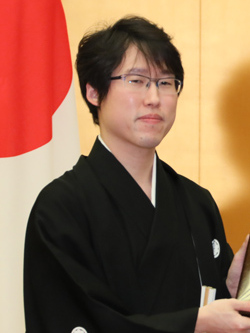Related Research Articles

The Nihon Ki-in (日本棋院), also known as the Japan Go Association, is the main organizational body for Go in Japan, overseeing Japan's professional system and issuing diplomas for amateur dan rankings. It is based in Tokyo. The other major Go association in Japan is Kansai Ki-in. Its innovations include the Oteai system of promotion, time limits in professional games, and the introduction of issuing diplomas to strong amateur players, to affirm their ranks.
Masao Kato Honorary Oza, also known as Kato Kensei, was a Japanese professional go player. A late bloomer, Kato won 46 titles, including the Oza eight times in a row. He also became the second player to reach 1,200 career wins, behind Rin Kaiho.

Cho Chikun25th HoninboHonorary Meijin is a professional Go player and a nephew of Cho Namchul. Born in Busan, South Korea, he is affiliated to Nihon Ki-in. His total title tally of 75 titles is the most in the history of the Japanese Nihon Ki-in. Cho is the first player to hold the top three titles—Kisei, Meijin, and Honinbo—simultaneously which he did for three years in a row. Cho is the first in history to win all of the "Top 7" titles in Japan which he achieved by winning the Oza in 1994. Cho U in 2011 and Iyama Yuta in 2013 would duplicate this feat, both by winning the Kisei. He is also one of the 'Six Supers' Japanese players that were most celebrated in the late twentieth century, along with Rin Kaiho, Otake Hideo, Takemiya Masaki, Kato Masao and his classmate and arch-rival Kobayashi Koichi. He is the author of several books on Go.

Rin Kaihō or Lin Haifeng is a professional Taiwanese Go player who made his name in Japan. He is, along with Cho Chikun, Kobayashi Koichi, Otake Hideo, Takemiya Masaki and Kato Masao, considered one of the 'Six Supers' that dominated Japanese Go world in the last three decades of the twentieth century.
Cho U is a Taiwanese professional Go player. He currently ranks 6th in the most titles won by a Japanese professional; his NEC Cup win in 2011 put him past his teacher Rin Kaiho and Norimoto Yoda. Cho is the first player in history to have held five of the top seven major titles simultaneously with Iyama Yuta being the second. Cho U, Naoki Hane, Keigo Yamashita and Shinji Takao make up the group of players in Japan called the "Four Heavenly Kings". His wife is one of Japan's best female go professionals, Izumi Kobayashi, the great Kitani's granddaughter and daughter of Kobayashi Koichi.

Yuta Iyama Kisei, Honinbo, Meijin is a Japanese professional Go player. In April 2016, he became the first player in Japanese history to hold all seven major titles simultaneously. In January 2018, Iyama became the first professional Go player to be awarded Japan's People's Honour Award.
Keigo Yamashita is a professional Go player. Yamashita adopted the name Honinbo Dowa after winning his first Honinbo title in 2010.
Koichi Kobayashi is a Japanese Go player. He is one of the 'Six Supers' who championed Japanese Go in the last three decades of Japanese Go.
Professional Go players in Japan are given the title of "Honorary" title holder if they either win the title ten times in a row, or have won the title five times in a row or ten times in total and reach the age of 60 years or retire. Below is a list of the honorary title holders and which title they are honored for.
The NEC Cup was a Go competition, supported by NEC Corporation between 1982 and 2012.
Yoshio Ishida is a professional Go player and author of several books on Go.
Shuzo Awaji is a professional Go player.
The 1st Kisei was the birth of a new Go tournament. Since this was the first year of the tournament, there was no set challenger or holder. From the 2nd edition on, there has been a playoff between challengers. At the time, it was the highest paying tournament there had ever been, and would be until the creation of the Ing Cup. Fujisawa Hideyuki's win would mark the beginning of a six-year defense of the Kisei title from 1977 to 1982.
The 9th Kisei was the 9th edition of the Kisei tournament. Since Cho Chikun won the previous year, he is given an automatic place in the final. Eight players battled in a knockout tournament to decide the final 2. Those two would then play each other in a best-of-3 match to decide who would face Cho. Takemiya Masaki became the challenger after beating Kobayashi Koichi 2 games to 1, but lost to Cho 4 games to 3.
The 11th Kisei was the 11th edition of the Kisei tournament. Since Koichi Kobayashi won the previous year, he is given an automatic place in the final. Eleven players battled in a knockout tournament to decide the final 2. Those two would then play each other in a best-of-3 match to decide who would face Kobayashi. Masaki Takemiya became the challenger after beating Hideo Otake 2 games to 1, but he would lose to Kobayashi 4 games to 1 in the final.
The 45th Judan was held from May 11, 2006 to April 25, 2007. The current sponsor is Sankei Newspapers. The holder is Cho Chikun, and the challenger is Keigo Yamashita for the second time in-a-row. Hideki Komatsu, Norimoto Yoda, Kimio Yamada, Hideo Otake, Koichi Kobayashi, Kim Shushun, Naoki Hane, and Takeshi Sakai qualified through preliminary tournaments. The rest of the players were given spots automatically.
The Igo Masters Cup was a Japanese Go competition. It was held nine times from 2011 until 2019, when it was discontinued. The tournament sponsor was Fumakilla, a chemical manufacturing company.
References
- ↑ "Brand New Tournament: Go Master's Cup". nihonkiin.org.jp/english. Archived from the original on 12 June 2011. Retrieved 12 June 2011.
- ↑ "1st Igo Masters Cup". igokisen.web.fc2.com. Retrieved 12 June 2011.[ permanent dead link ]